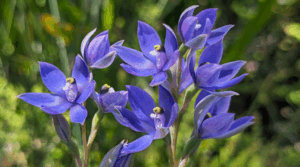Volunteers survey various areas across WA every April and, as the name suggests, count cockys – Baudin’s Black-Cockatoo, the Forest Red-tailed Black-Cockatoo and Carnaby’s Black-Cockatoo. All are listed as “rare or likely to become extinct and therefore in need of special protection” under the Western Australia Wildlife Conservation Act 1950.
GROWING SUPPORT
Adam Peck, Great Cocky Count Coordinator, helps organise the camp every year and says volunteer numbers have been growing.
“We started out with 250 volunteers in 2010 and this year we had 700 registered volunteers but more than 1000 turned up,” he says.
“This allows us to survey more sites—the number has pretty much doubled from 180 to 400.”
Adam says about 50% of the volunteers come back year after year. One of these volunteers is John Clarke who uncovered a ‘megaroost’ of Carnaby’s Black-Cockatoos in the Pinjar pine plantation during the Great Cocky Count in April last year.
GROWING involved
John, a forester, says he’s always been fascinated by bird life and forest maps.
“I’ve always been interested in birds, ever since I was a kid,” John says.
“So about six years ago, I went along to a BirdLife information session and put my name down.”
“I approached them about the pine plantations north of Perth and asked if they wanted me to watch any of those areas, as I know the cockys like the pine trees for food and roosting.”
John has kept an eye on the Pinjar pine plantation for the last four or five counts and during this year’s count he tracked the birds—noting where they were, the time they flew in and the best spot to view them from.
discovering a megaroost
“I’d been up there the week before the count,” he says.
“I climbed this little mound and guessed where they were going to come from. And sure enough, they came in big numbers.”
Counting as a team, John’s wife Louise and another volunteer member, Laura, worked as scribes.
“It was a great phenomenon to behold because we were perched on this rock in the plantation and they flew from the west overhead, 20 feet above our heads. The numbers just kept coming,” John says.
They counted a total of 4 897 black cockatoos, blowing previous records of roost numbers out of the water.
“It was just astronomical and was four times as much as previous years. When I called Adam and his crew the next morning to tell him, he couldn’t believe it,” John says.
“It was just astronomical and was four times as much as previous years. When I called Adam...the next morning to tell him, he couldn’t believe it.”
bird numbers are still declining
Although this number set a record, it sadly doesn’t mean there are actually more birds in the area.
“There’s still a 10% decline in local numbers,” Adam says. “Roosts are getting more condensed due to land clearing, which explains the presence of a ‘megaroost’.”
BirdLife runs workshops before the count, showing volunteers how to do the count and educate them on the biodiversity, behaviour and identification of the black cockatoos.
Want to volunteer for the 2017 Great Cocky Count? It’ll be held Sunday, April 9 and registration is due by March 19.







